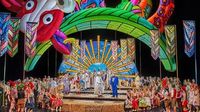In the hallowed halls of Wagner’s home theater in Bayreuth, Germany, a fresh breeze of innovation and playful color has swept through the 2025 staging of the composer’s beloved opera, Die Meistersinger von Nürnberg. On August 15, 2025, audiences gathered with anticipation, only to be met by a dazzling Technicolor spectacle—and a sharp twist to the classic tale that’s sure to spark conversation far beyond the festival’s ornate doors.
The production, helmed by director Matthias Davids, is slated to run through August 22, but it’s already making waves for its bold reinterpretation of the story’s ending. Traditionally, the opera concludes with the knight Walther joining the guild of master singers and preparing to marry Eva after clinching victory in the song contest. Not this time. Instead, in a moment that left many in the audience blinking in surprise, Eva—played by soprano Christian Nilsson in her debut of the role—snatches the winner’s medal from Walther’s hands, returns it to her father, and leads her would-be husband offstage. Their future, it’s clear, will be one that forsakes the weighty traditions of both family and city.
“No thank you. Let’s go!” Nilsson explained, reflecting on her character’s newfound agency. “She is a strong girl.” According to the Associated Press, this twist is not merely a fleeting change, but a deliberate statement woven throughout Davids’ production—one that emphasizes entertainment, color, and a certain irreverent humor often missing from Wagner’s typically solemn works.
Davids, a 63-year-old German director celebrated for his work in musical theater, leaned into the comedic possibilities with gusto. “I saw some productions and I always found them kind of heavy and meaningful,” he said, describing his approach. Drawing inspiration from Wagner’s own letters—where the composer confessed a desire to create a comedy that might fill his coffers—Davids set out to find “lightness and humor,” though he admitted, “comedy can’t constantly sustain over four hours.”
The result? A set that’s as much a feast for the eyes as it is for the imagination. There’s an upside-down inflatable cow—yes, you read that right—center stage, a whimsical nod to the production’s playful spirit. This bovine behemoth, manufactured by a company specializing in inflatables and coated with flame-retardant material, looms over the action. Its symbolism runs deep: “We were always referring to Eva as the prize cow. We said she is sold like a prize cow,” Davids quipped, referencing the opera’s original portrayal of Eva as a prize to be won.
The spectacle doesn’t stop there. Eva’s grand entrance for the Feast of St. John is a floral extravaganza, with the character encased in blossoms and carried aloft by four men. The set, designed by Andrew Edwards, features a tiny St. Catherine’s Church perched atop 34 steep steps, and fairground-inspired orange and yellow spears of light that echo the architecture of the Bayreuth auditorium. Even the church’s circular lamps and the audience’s own seats are mirrored in the stage design, blurring the line between observer and participant.
Costume designer Susanne Hubrich took the opportunity to inject a bit of contemporary and local flavor into the proceedings. Eva dons a traditional dirndl, while Walther, played by tenor Michael Spyres (also making his debut in the role), sports a punkish T-shirt—a cheeky contrast to the opera’s medieval roots. The townspeople, meanwhile, parade around in conical red caps that lend them an elf-like appearance. Some are even dressed to resemble German pop culture icons: entertainer Thomas Gottschalk, comedian Loriot, fans of the soccer club Kickers Offenbach, and, most notably, former Chancellor Angela Merkel.
“Ms. Merkel is a Wagner fan and attends the Bayreuth Festival almost every year,” Hubrich shared. “I spoke with her after opening night. She was amused.” It’s a detail that underscores the festival’s enduring appeal—and its ability to surprise even its most distinguished regulars.
The opera’s climactic moments are no less inventive. During Hans Sachs’ impassioned oration defending the imperative of German art, the character Beckmesser—played with just the right amount of fussiness by Michael Nagy—pulls the plug on the inflatable cow, causing it to sag and dim. Sachs, portrayed by Georg Zeppenfeld as a grandfatherly figure in an argyle sweater vest, scrambles to reinflate the cow, restoring the light. Yet, in a pointed reversal of the opera’s traditional ending, the young lovers reject Sachs and all he stands for, striding offstage to forge their own path. The townspeople, many of them in their whimsical red caps, simply shrug as Sachs and Beckmesser argue in the background, the old guard left to bicker as the future marches on.
For Nilsson, the chemistry with Spyres was key to the production’s fresh energy. “I really felt like in this production Eva and Walther truly had a fun connection—fun, young, loving connection—and I just leaned into that and listened to Spyres’ beautiful tenor,” she said, her smile as radiant as her character’s final act of rebellion.
Davids’ vision stands in stark contrast to previous Bayreuth stagings, such as Barrie Kosky’s 2017 production, which was set partly in Wagner’s home of Wahnfried and the Nuremberg trials courtroom, with Walther and Sachs portrayed as Wagner at different ages. This time, the focus is on joy, color, and a gentle poking of fun at the opera’s more ponderous traditions.
Musically, the performance was in expert hands. Conductor Daniele Gatti, returning to Bayreuth for the first time since 2011, led the orchestra and cast through the evening’s shifting moods with assurance. The reception? Overwhelmingly positive. “Just looking around the audience, there was a lot more smiles on people’s faces at the end than normally you see at the end of Wagner productions,” Nilsson observed. For a composer whose works are often associated with gravitas and grandeur, that’s no small feat.
It’s clear that this 2025 Bayreuth production of Die Meistersinger von Nürnberg is more than a simple update; it’s a vibrant reimagining that honors Wagner’s legacy while daring to ask what happens when tradition is left behind. Audiences may debate the merits of the twist, but there’s no denying the festival’s enduring power to provoke, delight, and reinvent itself for a new generation.






